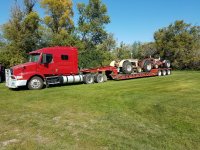Barnyard, you definitely poked the hornets nest here. I agree with the others that the medium duty synco 5-6-7 speed transmissions shift like garbage. Now none of these guys have driven a class 8 truck with a synchro box. The Europeans have had them for decades. The family truck business i grew up around was not afraid to try a few different things. We had a couple Scania trucks and quite a few Volvos with synchronized transmissions. Air assist clutch, and some had air assist shift. One finger could push the clutch pedal down or move the shift lever. The latest of the Volvos were a 14 speed, driving you used 3 slots with high and low range, plus a split in each that you just lifted off the throttle to shift.
One of those Scanias was a short day cab used as yard jockey. All it did was get shifted all day. I think it got 3 clutches in 35000 hours. It got shipped to South America when the frame was too rotten to pass inspection.
I would take one of the Euro synchro boxes any day over an American heavy truck transmission, and yes I drove over the road for about 10 years.
On the topic of double clutching, you can shift faster in tough conditions by double clutching, ie mud, soft fields, starting out on steep grades etc. But as others said, American clutches are tough on the joints, so not something you want to do all the time.
Currently, I have a Volvo with an automated 12 speed, it is not bad, there are a number of settings that can be programmed, starting gear, skip shifting, also, the dealer can load different software packages for specific uses that give the transmission a different personality. I would not want to drive it with out the manual override option where the driver can select the desired gear for specific conditions. I added that to my truck. I probably would not have bought the auto, but the wife said she would not drive without it.
View attachment 65678



